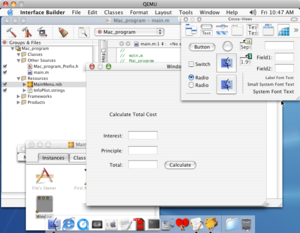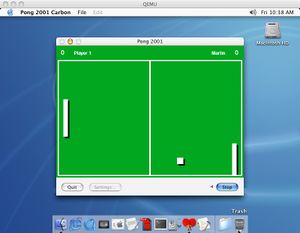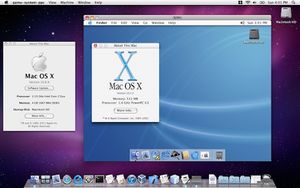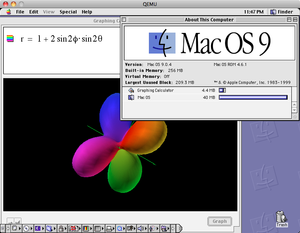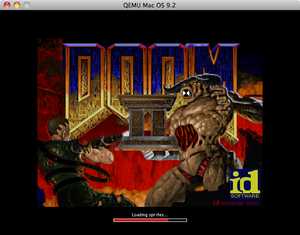Documentation/Platforms/PowerPC: Difference between revisions
| Line 6: | Line 6: | ||
<table> | <table> | ||
<tr style="text-decoration:underline;"> | <tr style="text-decoration:underline;"> | ||
<td width= | <td width=130px>Operating System</td><td>Status</td> | ||
</tr> | </tr> | ||
<tr> | <tr> | ||
Revision as of 10:08, 23 June 2018
PowerPC Macintosh Emulator
Description
An emulator of the Apple Beige Power Mac G3 and Sawtooth Power Mac G4.
Guest Compatibility
Note: information based on QEMU builds from 23-06-2018
| Operating System | Status |
| Mac OS 8.0 to 8.6 | Not supported |
| Mac OS 9.0 | 9.0.4 with rom version 5.6 and above (e.g., 9.0.4 for the Cube) boot. |
| Mac OS 9.1 | Boots and installs |
| Mac OS 9.2 | Boots and installs |
| Mac OS 10.0 | Boots and installs |
| Mac OS 10.1 | Boots and installs |
| Mac OS 10.2 | Boots and installs |
| Mac OS 10.3 | Boots and installs |
| Mac OS 10.4 | Boots and installs |
| Mac OS 10.5 | Boots and installs |
| Debian Linux 5 | Boots and installs |
| Ubuntu Linux 5 | Severe video corruption prevents using it |
| Lubuntu 12.04 | Boots live CD and installs, but installation does not boot |
Build Directions
./configure --target-list=ppc-softmmu && make
Guest Installations
Mac OS/Mac OSX
Mac OS 9.x
Command-line options to install Mac OS 9:
./qemu-system-ppc -M mac99,via=pmu -m 512 -hda <hd image file> -cdrom <iso file of installation media> -boot d -netdev user,id=mynet0 -device sungem,netdev=mynet0
Mac OS 10.X
Command-line options to install Mac OS 10.X:
./qemu-system-ppc -M mac99,via=pmu -m 512 -hda <hd image file> -cdrom <iso file of installation media> -boot d -netdev user,id=mynet0 -device sungem,netdev=mynet0
Mac OS X Server 1.2v3
Installation requires several steps:
Step 1: boot from installation CD, use disk utility to partition disk as Apple Server, quit Qemu and reboot with command line in step 2.
./qemu-system-ppc -L pc-bios -boot d -M mac99,via=pmu-adb -m 256 -net none -prom-env "auto-boot?=true" -prom-env "vga-ndrv?=true" -prom-env "boot-args=-v" -sdl -cdrom OSXServer1.2v3.iso -hda OSXServer1.2v3.qcow2
Step 2: initial installation (note machine and CPU, otherwise no desktop is shown).
./qemu-system-ppc -L pc-bios -boot d -M g3beige -cpu G3 -m 256 -prom-env "boot-args=-v" -prom-env "auto-boot?=false" -net none -sdl -hda OSXServer1.2v3.qcow2 -cdrom OSXServer1.2v3.iso
At the boot prompt enter "boot cd:9,\\:tbxi" Initial installation starts. Quit Qemu after completion.
Step 3: Installation continued. Boot with the following command line to complete the installation.
./qemu-system-ppc -L pc-bios -boot c -M g3beige -cpu G3 -m 256 -prom-env "boot-args=-v" -prom-env "auto-boot?=true" -net none -sdl -hda OSXServer1.2v3.qcow2 -cdrom OSXServer1.2v3.iso
Step 4: Boot the installed system:
./qemu-system-ppc -L pc-bios -boot c -M mac99,via=pmu-adb -m 256 -prom-env "boot-args=-v" -prom-env "auto-boot?=true" -net none -sdl -hda OSXServer1.2v3.qcow2 -cdrom OSXServer1.2v3.iso
Linux
Mac OS 9 Debugging tips
Macsbug can be used to tell you what exactly stopped booting. The link for it is below.
Mac OS 9.2 comes with a built-in debugger. To use it, set the OpenBIOS variable “APPL,debug”:
Via QEMU's command-line options:
-prom-env aapl,debug=2000000
In OpenBIOS type:
dev /
2000000 encode-int *Note: the number can be replaced with the many options available
“ AAPL,debug” property
then to boot from a cd type:
boot cd:,\\:tbxi
To boot from a hard drive image:
boot hd:,\\:tbxi
Emulated hardware issues
Linux is able to use a wide variety of emulated hardware available to QEMU. Sound and networking devices work well with it.
Mac OS 9 and Mac OS X currently only support sound in experimental builds.
Links
Google Summer of Code Discussion for Mac OS 9
Macsbug 6.6.3 - debugger for Mac OS 9
Darwin OS installation iso file
JQEMU - graphical manager for QEMU (requires Java)
PowerPC Assembly Language Tutorial
QEMU PowerPC mailing list
Beige Power Mac G3 info
Sawtooth Power Mac G4 info
Pictures
How do I help
QEMU has many systems that can always be improved. Here is a brief list of possible areas you may want to work on:
- Documentation
- Testing
- Fixing operating system compatibility issues
- PowerPC emulation
- User interface
- OpenBIOS (firmware)
- Implement a sound card that is compatible with Mac OS 9 and Mac OS X. The usb-audio device is the closest to working on the Mac OS.
- Implement a 3D video card
- Improve various hardware (via-cuda, ata controller, etc..)
Knowledge in these areas could help:
- PowerPC Assembly
- 68K Assembly
- Embedded Programming
Contacts
Maintainer: David Gibson david@gibson.dropbear.id.au
If there are any issues with this page, please contact me

